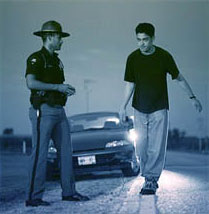BREATH TESTS
[vc_row css=”.vc_custom_1480959142372{background-color: #ffffff !important;}”][vc_column][vc_row_inner][vc_column_inner][vc_column_text css=”.vc_custom_1481071386415{padding-right: 35px !important;padding-left: 35px !important;}”]
Breath Tests
Are breath tests completely reliable? Breath tests are critical for the prosecution. Most drivers take either a “PAS” test (preliminary alcohol screening test) by the side of the road and/or an actual breath test at the station after arrest. Exposing errors in breath test results is critical in a DUI case.
No matter how breath is tested for alcohol, the test results depend on presumptions that may not be correct for the person tested and thus cause an artificially high reading.
 First and foremost, every breath testing instrument converts the alcohol vapor in the lungs to an amount of alcohol by weight in blood. The breath machine presumes that 2100 parts of deep lung breath contains the same amount of alcohol as one part of lung blood. However, this 2100 to one ratio, called a partition ratio, is not correct for many persons. Studies have shown that the partition ratio varies from person to person and even within the same person at different times. Studies have shown that the two sexes, men and women, have different partition ratios.
First and foremost, every breath testing instrument converts the alcohol vapor in the lungs to an amount of alcohol by weight in blood. The breath machine presumes that 2100 parts of deep lung breath contains the same amount of alcohol as one part of lung blood. However, this 2100 to one ratio, called a partition ratio, is not correct for many persons. Studies have shown that the partition ratio varies from person to person and even within the same person at different times. Studies have shown that the two sexes, men and women, have different partition ratios.
Independent of the problem of presumptions is the failure for breath machines to be able to identify ethanol to the exclusion of all other chemicals. In another words, the breath machine will detect other chemicals and identify them as ethanol. As such, a person could have a high blood level alcohol reading but actually have little ethanol in his/her blood.
Additional problems in breath testing occur if the tests occur during the absorptive phase. Absorption is the distribution of alcohol; alcohol is not evenly distributed until absorption ends. Absorption takes between 45 minutes to 2 hours to occur completely. However, food in the stomach can delay this process significantly, up to two or more hours. If tested before absorption is complete, some parts of the body have greater concentrations of blood alcohol than others. Thus, testing for alcohol within the absorption phase could result in an artificially high blood alcohol reading.
DISCLAIMER: The results of any person’s DUI case described on this web site and/or in the Bay Area DUI Law newsletter depend on factual and legal circumstances that are unique to a specific person. Information provided by this web site and/or the Bay Area DUI Law newsletter does NOT constitute a guarantee, warranty or prediction regarding the outcome of your legal matter. Any reference to laws, procedures, punishment or license consequences at court or the DMV in this web site and/or Bay Area DUI Law newsletter is NOT intended to be complete description of what can and will happen in any or every DUI case but instead is a simplified summary to facilitate the reader’s understanding of general issues involving DUI law. The law is in constant change; penalties and consequences change; as such, the reader should not and cannot rely upon anything mentioned in this web site and/or Bay Area DUI Law newsletter. The reader is strongly advised to seek competent legal counsel to ascertain the law, penalties and consequences that apply to his/her unique circumstances.[/vc_column_text][/vc_column_inner][/vc_row_inner][/vc_column][/vc_row]
At a Glance
Mark Blair
- Law Office of Mark Blair | Bay Area DUI Law
- Over 39 years of DUI experience
- 10.0 “Superb” Avvo Rating
- Hundreds of 5 Star Reviews
- GREAT DUI RESULTS
- Learn more
